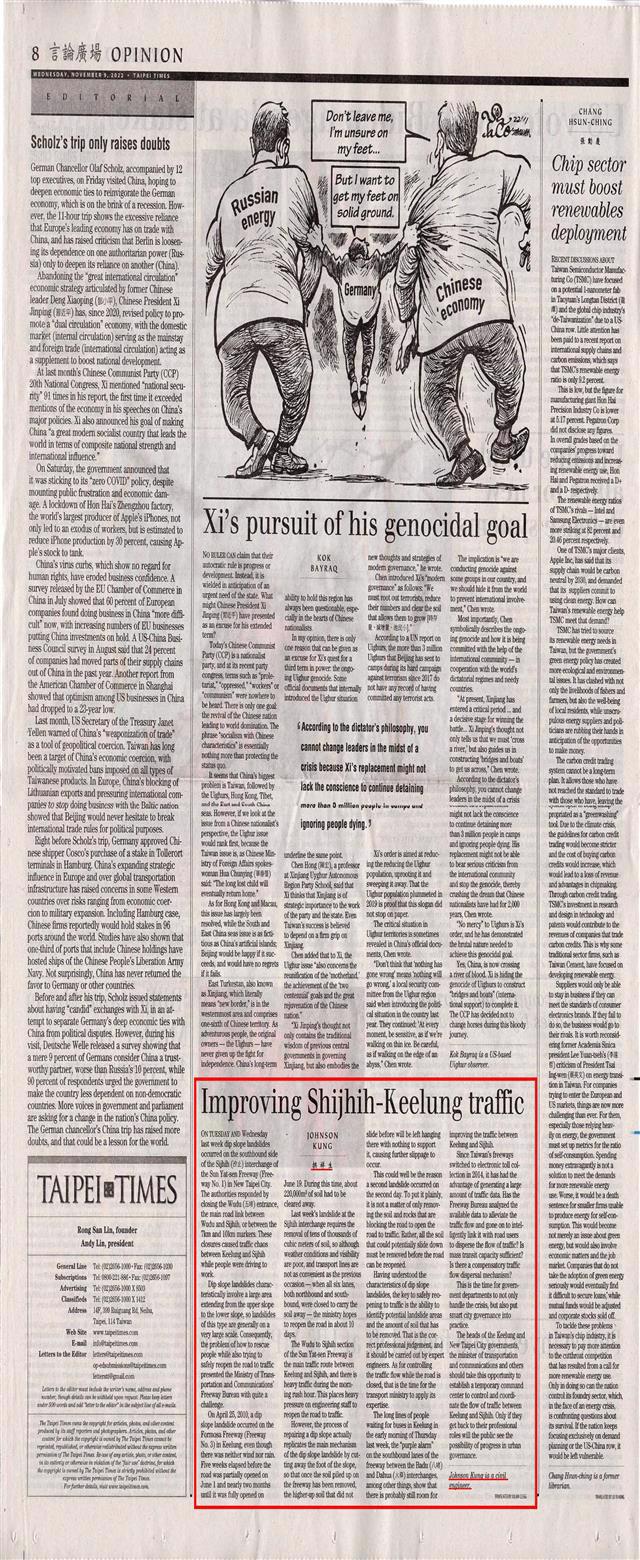On Tuesday and Wednesday last week dip slope landslides occurred on the southbound side of the Sijhih (汐止) interchange of the Sun Yat-sen Freeway (Freeway No. 1) in New Taipei City. The authorities responded by closing the Wudu (五堵) entrance, the main road link between Wudu and Sijhih, or between the 7km and 10km markers. These closures caused traffic chaos between Keelung and Sijhih while people were driving to work.
Dip slope landslides characteristically involve a large area extending from the upper slope to the lower slope, so landslides of this type are generally on a very large scale. Consequently, the problem of how to rescue people while also trying to safely reopen the road to traffic presented the Ministry of Transportation and Communications’ Freeway Bureau with quite a challenge.
On April 25, 2010, a dip slope landslide occurred on the Formosa Freeway (Freeway No. 3) in Keelung, even though there was neither wind nor rain. Five weeks elapsed before the road was partially opened on June 1 and nearly two months until it was fully opened on June 19. During this time, about 220,000m3 of soil had to be cleared away.
Last week’s landslide at the Sijhih interchange requires the removal of tens of thousands of cubic meters of soil, so although weather conditions and visibility are poor, and transport lines are not as convenient as the previous occasion — when all six lanes, both northbound and southbound, were closed to carry the soil away — the ministry hopes to reopen the road in about 10 days.
The Wudu to Sijhih section of the Sun Yat-sen Freeway is the main traffic route between Keelung and Sijhih, and there is heavy traffic during the morning rush hour. This places heavy pressure on engineering staff to reopen the road to traffic.
However, the process of repairing a dip slope actually replicates the main mechanism of the dip slope landslide by cutting away the foot of the slope, so that once the soil piled up on the freeway has been removed, the higher-up soil that did not slide before will be left hanging there with nothing to support it, causing further slippage to occur.
This could well be the reason a second landslide occurred on the second day. To put it plainly, it is not a matter of only removing the soil and rocks that are blocking the road to open the road to traffic. Rather, all the soil that could potentially slide down must be removed before the road can be reopened.
Having understood the characteristics of dip slope landslides, the key to safely reopening to traffic is the ability to identify potential landslide areas and the amount of soil that has to be removed. That is the correct professional judgement, and it should be carried out by expert engineers. As for controlling the traffic flow while the road is closed, that is the time for the transport ministry to apply its expertise.
The long lines of people waiting for buses in Keelung in the early morning of Thursday last week, the “purple alarm” on the southbound lanes of the freeway between the Badu (八堵) and Dahua (大華) interchanges, among other things, show that there is probably still room for improving the traffic between Keelung and Sijhih.
Since Taiwan’s freeways switched to electronic toll collection in 2014, it has had the advantage of generating a large amount of traffic data. Has the Freeway Bureau analyzed the available data to alleviate the traffic flow and gone on to intelligently link it with road users to disperse the flow of traffic? Is mass transit capacity sufficient? Is there a compensatory traffic flow dispersal mechanism?
This is the time for government departments to not only handle the crisis, but also put smart city governance into practice.
The heads of the Keelung and New Taipei City governments, the minister of transportation and communications and others should take this opportunity to establish a temporary command center to control and coordinate the flow of traffic between Keelung and Sijhih. Only if they get back to their professional roles will the public see the possibility of progress in urban governance.
Johnson Kung is a civil engineer.
Translated by Julian Clegg
| 


